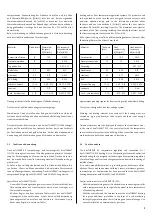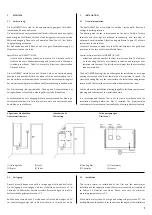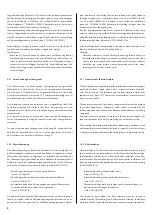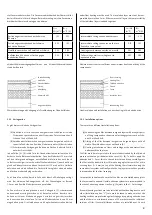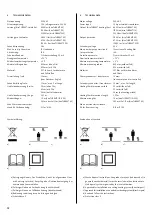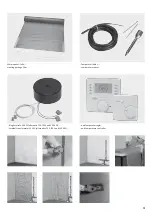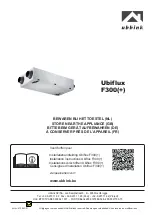
10
sich bei mehrbahniger Verlegung nicht berühren oder kreuzen.
Zur Installation des Reglers und Fühlers siehe Abschnitt 3.3 Elektrischer
Anschluss.
3.2.4 Einbau unter Fliesen
Vor der Verklebung der Fliesen muss die Heizfolie mit flexiblem Fliesen-
kleber vollständig in einem Dünnbettverfahren und einer 1-2 mm starken
Deckschicht verlegt werden. Die Oberfläche muss nach Vorschrift des Kle-
berherstellers getrocknet sein. Bei der Verlegung von mehreren Bahnen ist
auf einen ebenen Ausgleich zu achten.
3.2.5 Deckeneinbau
Bei der Installation der hicoTHERM®-Heizfolie in einer abgehängten Decke
oder wenn diese von einem Dachraum zugänglich ist, muss ein Warnschild
„Deckenheizung direkt wirkend“ an der Zugangsöffnung der Decke ange-
bracht werden.
3.2.6 Einsatz in Feucht-/Nassräumen
Beim Einsatz in Feucht-/Nassräumen sind die Vorgaben aus der DIN VDE
0100 zu berücksichtigen. Der Trafo und die sonstigen Komponenten sind
grundsätzlich für den Einsatz in Feucht- und Nassräumen geeignet.
3.3 Elektrischer Anschluss
Die Installation der elektrischen Komponenten darf nur durch einen zu-
gelassenen Elektrofachmann erfolgen. Für das Heizungssystem ist eine
allpolige Trennvorrichtung vom Netz mit mindestens 3 mm Kontaktöff-
nungsweite je Pol in die feste Installation vorzusehen.
Als indirekten Berührungsschutz ist ein Fehlerstromschalter (FI mit 30 mA)
notwendig.
Speziell für hicoTHERM® 60:
An einem Ringkerntrafo 300 W dürfen maximal 3 Heizfolien
hicoTHERM® 60 von längstens je 2,25 m angeschlossen werden.
Speziell für hicoTHERM® 220:
An einem Ringkerntrafo 300 W darf eine maximale Bahnlänge der
Heizfolie von 2,25 m angeschlossen werden.
Der optional mitgelieferte Temperaturfühler ist mit einem Leerrohr und
einer Fühlerhülse mindestens 20 mm unter die Heizfolienkante und
möglichst nahe an die Heizfolienoberfläche zu installieren und an das
Regelgerät anzuschließen (siehe Installationsanweisung Regelgerät).
Vor dem Einbau und nach dem Einbau ins Putzsystem ist an den Kontakt-
stellen (Crimpkontakte) der elektrische Widerstand zu messen und für Ga-
rantieansprüche zu dokumentieren (Beachten Sie die Dokumentation). Bei
unveränderten Widerstandswerten sind die Sekundärleitungen des Trafos
an die Crimpkontakte anzubringen.
Achtung:
Weichen die Endwerte mehr als 10% vom Ausgangswert ab, so ist
mit einer Beschädigung der Kontakte oder der Heizfolie zu rechnen. In
diesem Fall dürfen Sie das Heizsystem nicht in Betrieb nehmen.
other, the individual sections and the copper contact strips must not touch
or cross each other.
See Section 3.3 Electrical connection for information about installation of
the controller and sensor.
3.2.4 Installation underneath tiles
Before the tiles are glued, the heating film must be installed completely
by a thin bed process with flexible tile adhesive and a top layer 1 – 2 mm
thick. The surface must be dried in accordance with the instructions issued
by the adhesive manufacturer. When several different sections are being
installed, care must be taken to make sure that the surface is flat.
3.2.5 Installation in ceilings
When hicoTHERM® heating film is being installed in a suspended ceiling
or when the film is accessible from an attic, a warning sign “Ceiling
heating – direct impact” must be attached to the access opening to the
ceiling.
3.2.6 Installation in wet conditions
When installation is being carried out in wet conditions, the specifications
made in DIN VDE 0100 must be observed. The transformer and the other
components are basically suitable for use in wet conditions.
3.3 Electrical connection
A licensed electrician must be deployed to install the electrical components.
An all-pole mains disconnection facility with a contact opening width per
pole of at least 3 mm must be provided for the heating system during
installation.
A circuit breaker (FI with 30 mA) is necessary as indirect contact protection.
Special instruction for hicoTHERM® 60:
A maximum of 2 hicoTHERM® 60 heating films with a maximum
length of 2.25 m each may be connected to a toroidal transformer.
Special instructions for hicoTHERM® 110/220:
A heating film section with a maximum length of 2.25 m may be
connected to a toroidal transformer.
The temperature sensor supplied as an optional extra must be installed
with an empty conduit and a sensor sleeve at least 20 mm underneath
the edge of the heating film and as close as possible to the heating film
surface and must be connected to the control unit (see the installation
instructions for the control unit).
The electrical resistance level must be measured at the contact points
(crimped contacts) and documented for guarantee claim purposes before
installation and after installation in the plaster system (Documentation).
If the resistance levels are unchanged, the secondary conductors of the
transformer must be attached to the crimped contacts.
Important to remember:
If the final levels differ more than 10% from the original level, damage
to the contacts or the heating film must be expected. You must not put
the heating system into operation in this case.





